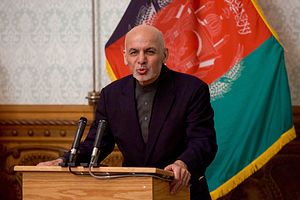The political tensions between Iran and the United States ratcheted up yet another notch when Iran shot down a U.S. drone on June 20, soon after being accused by Washington of an attack on oil tankers near the Gulf of Oman. U.S. President Donald Trump later claimed he had ordered a retaliatory strike on Iran, before reconsidering after hearing potential casualty counts. However, Trump did not exclude the possibility of an aggressive response in the future, and the United States added a wave of new sanctions on Iran yesterday. Any face-off between the two countries that would disrupt movement along the Strait of Hormuz would have significant implications for Afghanistan, the region, and beyond.
The strategically important Strait of Hormuz, a 15 mile-wide passage between Oman and Iran, is an important passage, not only for countries around Persian Gulf, but for those beyond the region as well. About 40 percent of the oil traded worldwide passes through this channel. The large oil producing countries around the Persian Gulf — including Qatar, Kuwait, Iran, and Bahrain – see all their oil exports transit the Hormuz Strait, while 90 percent of Saudi Arabia’s oil exports pass through this strait. This makes the passage one of the most important choke points worldwide.
The tense U.S.-Iran relations, rising possibility of confrontation and continued mounting pressure on Iran have significant implications for Afghanistan specifically. The landlocked country has historically depended on Pakistan as a transit route in light of international conventions and bilateral agreements. However, transit trade relations have remained turbulent given the capricious political ties between the two countries.
In recent years, the Afghan transit trade has shifted to Iran’s port city of Bandar e Abbas as an alternative transit route. Estimates show that the share of Afghanistan’s transit trade conducted via Pakistan, which stood at 60 percent in 2008-09, has dropped to less than 30 percent in 2016 while Afghan trade routed through Iran grew from roughly 20 percent to 40 percent in the same time frame. In an unprecedented move, Afghanistan is even working to establish its own shipping line to carry goods via Iran. While Afghanistan received waivers to buy oil from Iran amid the fresh sanctions imposed by the United States, its underlying transit trade endeavors stand to be be hurt severely as no exemptions can help should things get worse.
Future development plans risk being detailed as well. Two competing ports, Gwadar in Pakistan developed by China and Chabahar jointly developed by India and Iran, are located at close proximity to the Strait of Hormuz. While Chabahar serves as a gateway for India to reach Afghanistan and Central Asia, it will also provide a transit route and exclusive transit and trade benefits to Afghanistan as a partner once fully operational. Progress on the port, however, has been severely affected by the escalated U.S.-Iran tension since the project’s onset. In the meantime, continued economic downfall as a result of sanctions has constrained Iran’s capacity to contribute toward the development of port as planned. Therefore, any possible face-off would further dent the progress on Chabahar.
Afghanistan needs to learn an important lesson from the underlying situation. The shift in transit trade towards Iran’s Bandar e Abbas was the result of poor facilitation, overbearing security measures, an inefficient risk management system, and extortionate fees by Pakistani authorities. This trend further increased after relations between Iran and the United States improved in 2015. In the meantime, Afghan President Ashraf Ghani inherited regional transport corridor projects, namely Chabahar and Lapis Lazuli. While the complete operationalization of both projects has a long way to go, the Afghan president is presenting the shift in trade as a major achievement, implying that Afghanistan is no longer dependent on Pakistan for transit as part of his populist agenda.
But the recent uptick in tensions shows there are also dangers to being overly reliant on Iran for Afghanistan’s transit trade. Instead, it’s time to try again to tackle the issues between Kabul and Islamabad. The Afghanistan-Pakistan Transit Trade Agreement (APTTA) was signed in 2010 and meant to be revised in five years if needed and agreed by both parties. Key clauses in APTTA were unfair and harsh, making transit trade for Afghanistan challenging. It is important to renegotiate APTTA and ensure a smooth trade and transit route for Afghanistan to curtail any possible shocks to transit trade via Iran.
Given the political and economic significance of the Strait of Hormuz, and the messaging coming out of Washington, an extended and fierce face-off appears grimly probable in the near future. And things might get even worse between the two countries. Any interruption in shipping through the Strait of Hormuz and further escalation of U.S.-Iran tensions would certainly affect the interests of Afghanistan, the region, and beyond.
Shoaib A. Rahim is a regional economic analyst at the Afghanistan Affairs Unit (AAI), an Afghan think tank. He is keen observer of issues related to regional connectivity, economic cooperation, trade, and transit, and holds an MSc. Degree in Development Economics from University of Sussex, England. Follow him on Twitter @ShoaibBinRahim

































